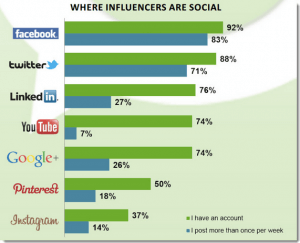By Jim Clanin
Blogs originated as personal online diaries, a way for users to express their thoughts to friends, family, and whatever strangers would listen. If you’d told web designers and marketing pros that in 2013, blogging would be one of the most powerful ways to sell their brand, you’d probably be met with laughter. But that’s where we are.
Recently, Technorati Media issued a report that provides some insight into just how powerful blogging is, and gives us a few clues about how to harness that power to sell our brand. They Surveyed 6,000 digital influencers, 1,200 consumers, and 150 top marketers. What they found surprised us.
1. Consumers trust blogs when making purchase decisions
When making a decision to purchase, consumers ranked retail sites (56%) and brand sites (34%) as their top two influencers. Coming in at a close third, at 31%, is blogs. That means that nearly as many people are checking out blogs as a brand’s dedicated site when they decide if they want to buy.
2. Most influencers blog
In fact, the term “digital influencer” is practically synonymous with “blogger.” 86% of influencers blog, and a third of them report that they’ve been blogging for more than 5 years. So if you want to be an influencer, a good first step is to start blogging.
3. The written word still wins
Lately, we’ve been seeing more and more slick infographics and multimedia content on social networks. So I was surprised to learn that the text blogging absolutely dominates multimedia posting when it comes to what influencers are putting out there. 86% of influencer’s posts are text, with only 38% photos and 10% video. It turns out, the written word is sticking around.
 4. Facebook and Twitter are way ahead of the other networks
4. Facebook and Twitter are way ahead of the other networks
Nearly all influencers have – and post at least weekly – facebook and twitter accounts. And while three quarters of them are on LinkedIn, Youtube, and Google+, most influencers report that they rarely post to these networks. Research also shows that facebook and twitter create the most referrals and shares, and in turn generate the most revenue. If you’re going to spend time on only a few social channels, facebook and twitter are the places to start.
5. Social is powerful, but money spent on it is minimal
The Technorati report shows us just how big a piece of the influence pie blogging takes up. Even so, only 10% of all digital advertising is spent on social, and a tiny 5% of that is devoted to advertising on blogs. Banner advertising, text ads, and affiliate programs are just a few ways to advertise. This shows that the time is ripe for web designers, marketers, and brands to harness the power of blogging. It’s an incredibly powerful channel, and one commands much respect from consumers, but most of your competitors aren’t there.
Remember, bloggers expect to be paid for their time, and they just might understand your audience better than you do, so listen up when they offer ideas.
How can you become a digital influencer through blogging, or capitalize on already established blogger networks to build your brand?








